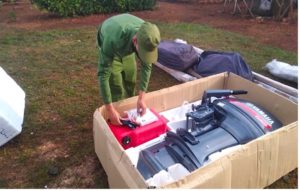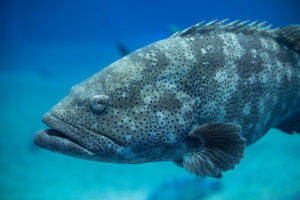WildAid Marine Expands Program in Cuba to Protect the Caribbean’s Most Pristine Coral Reefs
May 13, 2022; By Carolyn Sotka, Marine Grants Officer
Cuba’s coral reefs are considered the most diverse and biologically rich ecosystems in the Caribbean. Relatively free from the impacts of tourism, pollution and coastal development, these reefs have fared better than in neighboring countries, where coral cover has declined by at least 50%. Some suggest that the health of Cuba’s reefs has remained relatively intact over the last 50 years.
Despite those factors, species like the goliath grouper, and the hawksbill and loggerhead turtles remain critically endangered. Recognizing the importance of preserving these delicate ecosystems and the wildlife they support, Cuba has made it a priority to protect nearly 30% of their coastal waters. With an aim to stop illegal, unreported and unregulated (IUU) fishing and other threats, Cuba’s government invited WildAid Marine to help improve marine protected area (MPA) enforcement in 2020 at the Ciénaga de Zapata National Park.
The goliath grouper may grow as long as eight feet and weigh nearly 800 pounds, making it the largest type of grouper in the Gulf of Mexico, the Atlantic Ocean, and the Caribbean Sea. Credit: American Oceans
Given the success of our partnership, on May 3, 2022, Cuba’s National Center for Protected Areas (CNAP) and WildAid Marine signed a Technical Cooperation Agreement to expand and strengthen surveillance and enforcement capacity beyond Ciénaga de Zapata to all 100+ of Cuba’s MPAs, starting with two additional UNESCO Biosphere Reserve sites – the Alejandro de Humboldt National Park (AHNP) and Guanahacabibes National Park and Banco de San Antonio.

Omar Cantillo, Director of CNAP and Meaghan Brosnan Director of WildAid’s Marine Program sign an agreement to increase WildAid’s marine enforcement support of CNAP and SNAP. Other attendees included Manuel Bravo, Director for Latin America of WildAid, Director of Cuba’s Environment Agency of CITMA (Ministry of Science, Technology and Environment); Director of International Relations of CITMA, and Director of the Ranger Corps of the Ministry of the Interior.
In 2020, WildAid Marine delivered a comprehensive Marine Protection System (MPS) Plan for the Zapata Peninsula and the Ciénaga de Zapata National Park. Ciénaga de Zapata includes one of the largest and most important wetlands in the Caribbean region and is a UNESCO Biosphere Reserve and Ramsar Site. To date, implementation of the MPS Plan has included provision of critical surveillance and safety equipment for rangers and led to an increased number of patrols and exploration missions, an increase in detections of fishery violations, and improved marine protection for coasts and wildlife.
WildAid Marine will now expand patrol areas to new areas of the National Protected Areas System (SNAP), while continuing to provide marine enforcement expertise, technical assistance, regional peer to peer exchanges, and other related needs.
Today, Cuba has established over 100 MPAs that encompass 30% of Cuba’s coral reefs, 24% of seagrass beds, and 35% of mangrove ecosystems. The AHNP is among the most important sites in the Western Hemisphere for its endemic flora and one of the most biologically diverse tropical island sites on Earth. The Guanahacabibes Peninsula is a biological corridor for more than 50 migratory bird species, and its beaches are nesting grounds for three species of sea turtle. Its fringing coral reefs, extend about 80 km and host 42 species of hard corals, including some of the Caribbean’s last remaining healthy stands of black coral, as well as over 200 species of fish and invertebrates.
WildAid’s latest collaboration reflects decades of government policies and programs that demonstrate Cuba’s long-term commitment to conserving the island’s marine resources for the benefit of Cuban people.

Overview of MPA regions as part of SNAP. In October 2021, Cuba added Este del Archipiélago de Los Colorados (“East of Los Colorados Archipelago”), a new MPA on the northwest coast. Image Credit Bulletin of Marine Science.

In 2020, our first year of support – WildAid delivered two outboard motors, basic surveillance and safety equipment (e.g., GPS, digital cameras, VHF radios, and life jackets), and other supplies to rangers that patrol Ciénaga de Zapata.
Thank you to WildAid Board Member, Alan Chung for the cover photo of the Gardens of the Queen, Cuba – the largest no-take marine reserve in the Caribbean.
WILDAID MARINE’S STRATEGIC VISION FOR THE CARIBBEAN: To make the promise of marine protection real throughout the Caribbean by applying effective enforcement solutions to deter illegal fishing and strengthen protection of priority marine areas in Cuba, The Bahamas, and the Dominican Republic.
Subscribe to WildAid Marine’s Newsletter
